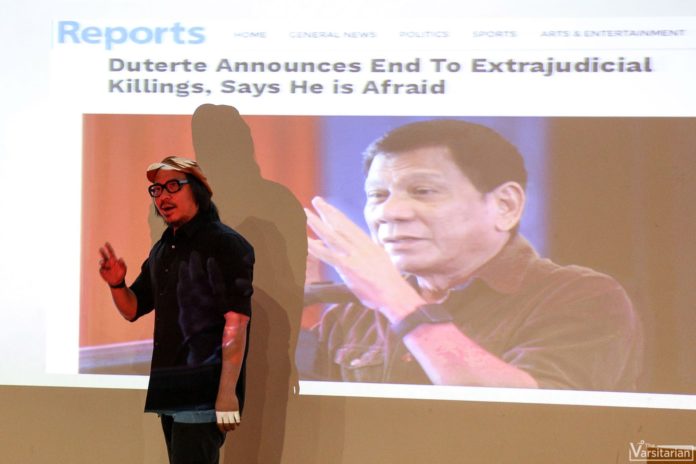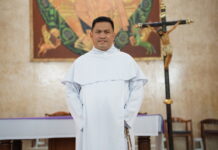
WHERE do campus journalists figure in the age of fake news sites and issues of national concern?
These were the hot topics addressed in the 18th Inkblots, the UST National Campus Journalism Fellowship held last Dec. 19 to 21. The conference had the theme “the campus press as an engine of democracy,” discussed in a series of lectures by the country’s top media practitioners.
“Ang katangian ng campus journalists noon hanggang panahon ng Martial Law ay tapang at talino,” broadcast personality and UST journalism alumnus Lourd de Veyra said in his keynote address before an audience of nearly 200 campus journalists at the Thomas Aquinas Research Complex auditorium.
De Veyra recounted the history of the College Editors’ Guild of the Philippines, the nationwide organization of student journalists.
He also narrated the stories of notable student journalists such as former Philippine Collegian editor in chief Wenceslao Vinzons, who became a politician and guerilla leader during the Japanese occupation, and Hasik editor in chief Liliosa Hilao, the first reported case of a murdered Martial Law detainee.
Inquirer.net editor in chief John Nery spoke about online trends in campus journalism. He urged campus publications to engage in issues that affect their community and country.
“It is completely untrue that millennials have no care in what’s happening in the world,” he said. “Your generation has influence. You are taking the lead.”
Debunk fake news
UST journalism lecturer Felipe Salvosa II, who is also managing editor of the Manila Times, highlighted the need for verification amid the spread of fake news online.
“Fake news has implications in our democratic societies because we use the news to make political opinions,” said Salvosa, a former Varsitarian editor in chief. “If you spread the wrong information, you help people make the wrong decisions. Fake news has its consequences.”
He added that campus journalists should be “the first ones to have the capability to spot fake news.”
New media, narratives
Philippine Daily Inquirer sports editor Francis Ochoa advised aspiring writers to give sporting events a different angle instead of simply reporting the game.
“Compelling narratives engage readers,” Ochoa said. ” If you learn to narrow your vision in a game, it’s easier to pick your angle.”
Nestor Cuartero, long-time editor at the Manila Bulletin, lectured on feature writing and gave tips on how to write a good feature story.
“It all boils down to that basic ingredient in journalism called human interest. Find something strange, ironic, unusual and out of the ordinary,” he said.
Cuartero ended his session with a mock press conference with actor Dingdong Dantes, encouraging fellows to be creative in their interview questions.
Cartoonist and “Kikomachine” author Manix Abrera encouraged students to draw inspiration for their stories from everyday experiences and develop their own art style by combining or experimenting on the styles of other artists.
“Wala tayong excuse na wala tayong maisip. Maraming kuwento sa ating paligid,” he said.
Post-truth
Lawyer Eldric Paul Peredo, who teaches at the UST College of Commerce, told the students to be accurate and fair in their reporting in the “post-truth” era.
“In choosing what to report, you’re accidentally shaping a narrative, sometimes consciously,” he said.
He advised campus writers to follow the code of ethics to avoid getting sued for libel.
Joe Torres, chairman of the Photojournalists Center of the Philippines, said there are biases even in photojournalism.
“It’s a political decision, yung pagkuha ng isang larawan. Walang pagiging objective sa pagkuha ng larawan,” he said during the photojournalism session.
Broadcast journalist Chiara Zambrano urged campus journalists to be brave in “delivering the truth.”
“Tindigan mo ang alam mong katotohanan, kahit na pilit kang pinatutumba,” said Zambrano, who covers defense and natural disasters for ABS-CBN News and Current Affairs.
“There is no story worth dying for, but there are a lot of stories worth risking your life for,” she said.
Bands MilesExperience and Oh Flamingo! performed in the fellowship dinner and awarding ceremony of the 2nd UST National Campus Journalism Awards.













